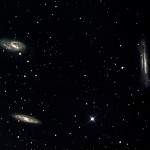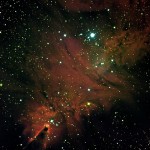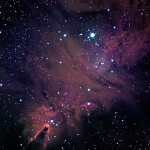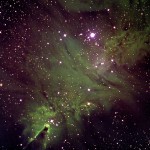-
Recent Posts
Recent Comments
- kevsadmin on September Observatory Construction
- Peter on September Observatory Construction
- Ivy Palmer on B33 Horse Head Nebula
- Ivy Palmer on Saturn – A Comparison of Stacked Images
- Keith on B33 Horse Head Nebula
Archives
Categories
Meta
Tags
Visitors
MARvellouS MARS
Take a look at the above Solar System/The Planets menu to see my recent images of Mars and exciting occultation of Mars by The Moon on 8 December 2022
Posted in Uncategorized
Leave a comment
C/2019 Y4 Atlas – A comet hurtling through our Solar System
Comet C/2019 Y4 Atlas could become a bright naked eye object in May 2020. The picture below was taken on 28 March 2020.
Comet C/2019 Y4 (Atlas) is currently approaching our Sun at over 35 km/s and will be closest to Earth on 23 May and closest to the Sun on 31 May. Comets are a mixture of frozen gases and rock that can sometimes develop an impressive tail, millions of miles long, as things warm up and they approach the Sun. We are well placed to witness this comet’s closest approach to the Sun in May and the Earth, especially in the northern hemisphere, could have a spectacular ring-side seat.
Currently, you can see the beginnings of a tail. The picture has also captured a small galaxy in the bottom right that is only a mere 2100 million light years away!
I estimate the dimmest star in the picture is around magnitude 17.
The comet picture consisted of 9 luminance shots mostly at 5 minutes a piece and 5 each of RGB at 3 mins each. Processed in PixInsight with a brief touch up in photoshop.
The centre of the shot is at RA 8h 16m 42.3s and Dec 68 32’ 16.9’’
Posted in Uncategorized
Leave a comment
Messier 51A and 51B Whirlpool Galaxy
Messier 51 is an interacting spiral galaxy in the constellation of Canes Venatici. It lies at a distance of approximately 23 million light years and is about 76,000 light years across.
The pronounced spiral structure of the Whirlpool Galaxy is believed to be the result of the close interaction between it and its companion galaxy NGC 5195, which may have passed through the main disk of M51 about 500 to 600 million years ago. In this proposed scenario, NGC 5195 came from behind M51 through the disk towards the observer and made another disk crossing as recently as 50 to 100 million years ago until it is where we observe it to be now, slightly behind M51.
Three supernovae have been observed in the Whirlpool Galaxy – 1994, 2005 and 2011.
Luminance: 25 frames, 240s, -20C, 1×1 bin, high gain
RGB: 15 frames each, 120s, -20C, 2×2 bin, low gain
Processing: PixInsight
Taken 26 March 2019
Orion Optics AG12 and QSI683 camera with Baader LRGB filters
Posted in Uncategorized
Leave a comment
Barnard 33 – Horsehead Nebula and NGC 2023
The Horsehead nebula is about 1500 light years from Earth, the bright reflection nebula to the bottom left is NGC 2023 and Alnitak (left hand star of Orion’s belt) is causing the flares emanating from the left hand side of the image.
The image was taken with an Orion Optics AG12 (1140mm focal length at F3.8) and QSI 683 camera and Maxim DL on 26 February 2019. Auto-guiding done with a 9×50 skywatcher 162mm focal length and lodestar. Sub frames (Baader LRGB filter set) consist of 20 luminance frames (180s 1×1 bin high gain -20C) and 12 sub frames each of RGB (90s 2×2 bin low gain -20C). Processed in PixInsight and a final high pass filter in Photoshop to enhance local contrast.
M27 Dumbbell Nebula (Planetary Nebula in Vulpecula)
The nebula lies about a quarter of the way from Altair to Deneb and consists of gases expelled from the central star that are being excited by the strong UV radiation emitted by this star and emit strongly at certain wavelengths.
Taken on 24-9-18, 12 subs each of LRGB, 120s exposures at 1×1 binning with a QSI 683 camera and a 300mm Orion Optics AG12. I’ve been working my way through Warren Keller’s book on PixInsight and this is my first attempt to process a set of subframes entirely with PixInsight. Compare the final result with 1 of the raw luminance subframes.
Posted in Uncategorized
Leave a comment
Messier 64 – Black Eye Galaxy 20 March 2018
This is my first attempt to use my new observatory and equipment after a year or so gap having moved house to Cornwall and built a new observatory. Having spent until 1:30am drift aligning the mount (I got nowhere with the Gemini II polar axis correction feature) I was determined to get a picture of something! LRGB image of messier 64. QSI 683 camera operating at -30C : 5 sub-frames each, luminance 300s 1×1 bin high gain; RGB 200s 2×2 bin low gain. Calibrated and aligned in Maxim DL. High pass filter applied and LRGB combine in photoshop.
Posted in Uncategorized
Leave a comment
Transit of Mercury – 9 May 2016
Please visit the page under the menu item Solar System/The Sun – Mercury Transit
Posted in Uncategorized
Leave a comment
Leo Triplet (M66 Group)
Leo Triplet (M66 Group). This LRGB image (L=11 images 600s 1×1 binning; only 1 image each of RGB 300s 2×2 binning all @-36C using AG12 and QSI683. Calibrated with darks and flats in Maxim DL. Combined in Maxim, stretched in Fits Liberator using Arcsinh function and scaled peak of 30.0. Some levels and curves adjusted in Photoshop and high pass filter applied.
This image is limited by the lack of RGB data (only 1 sub frame of each). Bad weather, lighter evenings, and a badly place apple tree have stopped me getting more data this year – wouldn’t be quite so bad if the apples were nice to eat 🙁
Posted in Uncategorized
Leave a comment
NGC2264 Christmas Tree Cluster – Cone Nebula and Fox Fur Nebula (Monoceros)
I concentrated on getting lots of H-Alpha data and limited OIII and SII frames. The following images are taken from 300s subs at 2×2 binning (low gain) with a QSI683 at -36C. 21 x H-alpha frames and 5 frames each for OIII and SII.
The frames were aligned, stacked and calibrated as mono-frames in Maxim and then had digital development applied (FFT low pass and hardness 90). Each mono frame had a high pass filter applied in Photoshop and then combined to an RGB image and the H-alpha frame re-used as a luminance frame giving a final LRGB frame.
Cone Nebula at bottom with inverted Christmas Tree cluster above the cone; the bright star just above the cone is the tree topper and the very bright star at the top of the image (S Monocerotis) is the center of the tree trunk. The Fox Fur Nebula is at the top right corner.
Ha=red; SII=green; OIII=blue:
Ha=red; OIII=green; SII=blue:
SII=red; Ha=green; OIII=blue (Hubble palette):
Posted in Uncategorized
Leave a comment










